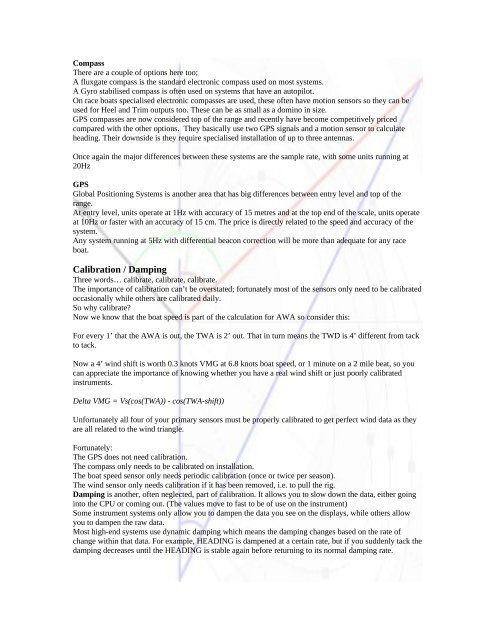Race boat instruments â understanding it all - L-36 Fleet
Race boat instruments â understanding it all - L-36 Fleet
Race boat instruments â understanding it all - L-36 Fleet
Create successful ePaper yourself
Turn your PDF publications into a flip-book with our unique Google optimized e-Paper software.
CompassThere are a couple of options here too;A fluxgate compass is the standard electronic compass used on most systems.A Gyro stabilised compass is often used on systems that have an autopilot.On race <strong>boat</strong>s specialised electronic compasses are used, these often have motion sensors so they can beused for Heel and Trim outputs too. These can be as sm<strong>all</strong> as a domino in size.GPS compasses are now considered top of the range and recently have become compet<strong>it</strong>ively pricedcompared w<strong>it</strong>h the other options. They basic<strong>all</strong>y use two GPS signals and a motion sensor to calculateheading. Their downside is they require specialised inst<strong>all</strong>ation of up to three antennas.Once again the major differences between these systems are the sample rate, w<strong>it</strong>h some un<strong>it</strong>s running at20HzGPSGlobal Pos<strong>it</strong>ioning Systems is another area that has big differences between entry level and top of therange.At entry level, un<strong>it</strong>s operate at 1Hz w<strong>it</strong>h accuracy of 15 metres and at the top end of the scale, un<strong>it</strong>s operateat 10Hz or faster w<strong>it</strong>h an accuracy of 15 cm. The price is directly related to the speed and accuracy of thesystem.Any system running at 5Hz w<strong>it</strong>h differential beacon correction will be more than adequate for any race<strong>boat</strong>.Calibration / DampingThree words… calibrate, calibrate, calibrate.The importance of calibration can’t be overstated; fortunately most of the sensors only need to be calibratedoccasion<strong>all</strong>y while others are calibrated daily.So why calibrate?Now we know that the <strong>boat</strong> speed is part of the calculation for AWA so consider this:For every 1’ that the AWA is out, the TWA is 2’ out. That in turn means the TWD is 4’ different from tackto tack.Now a 4’ wind shift is worth 0.3 knots VMG at 6.8 knots <strong>boat</strong> speed, or 1 minute on a 2 mile beat, so youcan appreciate the importance of knowing whether you have a real wind shift or just poorly calibrated<strong>instruments</strong>.Delta VMG = Vs(cos(TWA)) - cos(TWA-shift))Unfortunately <strong>all</strong> four of your primary sensors must be properly calibrated to get perfect wind data as theyare <strong>all</strong> related to the wind triangle.Fortunately:The GPS does not need calibration.The compass only needs to be calibrated on inst<strong>all</strong>ation.The <strong>boat</strong> speed sensor only needs periodic calibration (once or twice per season).The wind sensor only needs calibration if <strong>it</strong> has been removed, i.e. to pull the rig.Damping is another, often neglected, part of calibration. It <strong>all</strong>ows you to slow down the data, e<strong>it</strong>her goinginto the CPU or coming out. (The values move to fast to be of use on the instrument)Some instrument systems only <strong>all</strong>ow you to dampen the data you see on the displays, while others <strong>all</strong>owyou to dampen the raw data.Most high-end systems use dynamic damping which means the damping changes based on the rate ofchange w<strong>it</strong>hin that data. For example, HEADING is dampened at a certain rate, but if you suddenly tack thedamping decreases until the HEADING is stable again before returning to <strong>it</strong>s normal damping rate.
















